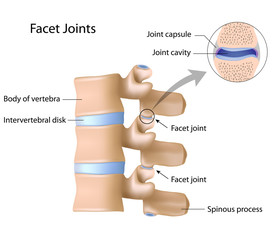
What is this condition? What causes this condition?
Low back pain is a condition causing pain in the lumbar spine. It is often caused by sitting for long periods of time, slouching in a chair, working on a computer or looking at a mobile phone for long periods of time. Sitting in this posture for extended periods causes bad posture, the neck and head leaning forward ultimately causes lower back muscle tightness. Sometimes it can be difficult to classify low back pain so it is referred to as ‘’non specific low back pain’’.
Facet joints are a joint on the vertebra found in the cervical, thoracic and lumbar spine. The joint assists in supporting and stabilising the spine and assists in preventing injury as it limits range of motion in movement planes (Cohen & Raja, 2007). All facet joints have slightly different shape and orientation due to playing different roles in movement. Ageing is thought to cause the facet joints to become weaker where the joint orientation changes can predispose them to rotational stresses causing injury (Cohen & Raja, 2007). Often weakness in multifidus (weak back muscle) can cause instability, this weakness is compromised by increasing the activity of the erector spinae which often tightens and causes stiffness in the lower back.
Common symptoms / signs
Low back pain symptoms include overactive hamstrings, hip muscles and ITB. These muscles are often overactive due to weakness in hip abductors, hip extensors and core muscles (Kim & Yim, 2020). During an examination the physiotherapist will attempt to reproduce the pain through the patient performing a series of movements. Generally, the movements are flexion, extension, lateral flexion and rotation. Pain in the facet joint during low back pain if usually pain in extension.
Risk factors of this condition?
- Living sedentary lifestyle causing muscle weakness (Shiri et al., 2019)
- Age- more common as you get older
- Excess weight adds more stress through the vertebrate
- Incorrect lifting technique and strenuous physical work
- Smoking
How is it treated?
Non operative approach to treating low back pain can include physical manual therapy, anti-inflammatory medications, strengthening and stretching exercises. Particularly strengthening exercises have been proven to improve pain, improve physical function and improve muscle strength and mental health (Owen et al., 2020). The main exercises prescribed are core strengthening and hip muscle strengthening exercises (Kim & Yim, 2020).
Other causes/differential diagnoses
Pain in the lower back in the facet joints can lead to spinal osteoarthrosis, disc degeneration or over exertion of the facets. Other common causes are due to high impact sports injuries or car accidents.
